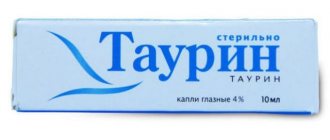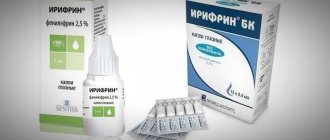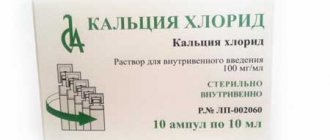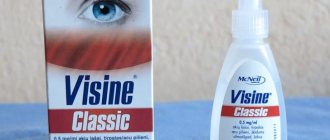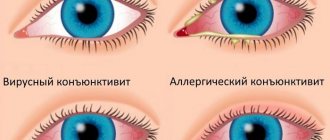Eye drops Dexamethasone 0.1% is a glucocorticosteroid for topical use. It is a powerful anti-inflammatory, anti-allergic and anti-exudative agent. It has the property of suppressing inflammatory reactions in response to mechanical, chemical or immune damage. Recommended for use by persons over 18 years of age.
Registration number: ЛС-001351
Trade name: Dexamethasone
International nonproprietary name: dexamethasone
Dosage form: eye drops
Photo of the packaging of dexamethasone eye drops showing the composition and price
Composition of the drug
Fluorinated prednisolone in eye drops Dexamethasone is a glucocorticoid agent (GCS). The active substance is contained in the form of sodium phosphate, its concentration is 0.1%. Various manufacturers also use polysorbate 80, benzalkonium chloride, and other auxiliary compounds.
1 ml of suspension = 23 drops, each of them contains 0.043 mg of Dexamethasone.
There is a plastic ring between the bottle and the cap to control tampering. When using for the first time, the cap is turned with force to separate it from the protective strip. The suspension is dispensed by pressing on the bottom of the bottle. With one pressure, 1 drop of liquid is released. Do not squeeze the walls of the bottle, as this will result in more suspension being poured out than necessary.
Pharmacodynamics and pharmacokinetics
Dexamethasone is a synthetic corticosteroid (adrenal cortex hormone). Wikipedia and the Vidal reference book indicate that the substance, when interacting with cytoplasmic receptors, forms complexes that penetrate the cell nucleus and stimulate the synthesis of m-RNA.
m-RNA, in turn, induces the biosynthesis of proteins (including enzymes that regulate vital processes in cells), which inhibit phospholipase A2, the release of arachidonic acid, the biosynthesis of endoperoxides, LT and PG, which are mediators of allergies, inflammation, pain, etc. .
Inhibits the activity of proteases, collagenase, hyaluronidase, as well as the release of inflammatory mediators from eosinophils, promotes:
- normalization of the function of the intercellular matrix of bone and cartilage tissue;
- decreased capillary permeability;
- stabilization of membranes (including lysosomal) cells;
- inhibition of the release of cytokines from macrophages and lymphocytes (gamma interferon and IL);
- involution of lymphoid tissue;
- acceleration of protein catabolism;
- decreased glucose utilization;
- increased gluconeogenesis in the liver;
- decreased absorption and increased excretion of Ca;
- Na and water retention;
- delayed ACTH secretion.
After oral administration, the substance is almost completely absorbed. The bioavailability of the drug in tablet form is up to 80%. Cmax and the maximum effect of use are observed after one to two hours. The effect after taking a single dose lasts for 2.75 days.
Binding to plasma proteins (mainly albumin) is approximately 77%.
The substance is fat-soluble, therefore it is able to penetrate both inside the cell and into the intracellular space. The action manifests itself in the central nervous system (pituitary gland, hypothalamus), which is due to the ability of dexamethasone to bind to cell membrane receptors.
In peripheral tissues it binds and acts through cytoplasmic receptors. Dexamethasone breaks down in the cell (at the site of its action). Metabolization occurs primarily in the liver and, partly, in the kidneys and other tissues. The main route of elimination is through the kidneys.
Why is the drug prescribed to adults and children?
Dexamethasone, as an anti-inflammatory agent, has a strong and long-lasting effect. GCS inhibits the biosynthesis of prostaglandins, histamine, and bradykinin. These properties are the basis for eliminating the inflammatory process, the disappearance of its main signs - redness, swelling, itching and pain.
Therapeutic effects of Dexamethasone:
- Suppresses the activity of phospholipase A2, inhibits the development of inflammation.
- Has an anti-exudative effect, prevents fluid from being released into the tissue.
- Reduces pain and swelling by reducing vascular permeability and blocking leukocytes.
- Reduces the release of allergy mediator - histamine.
Dexamethasone drops are a local glucocorticoid agent with an anti-inflammatory effect for use in ophthalmology. The drug also relieves allergies affecting the outer membranes of the eyes.
For what ailments are Dexamethasone drops prescribed:
- non-purulent inflammation of the membranes of the eye (conjunctiva, cornea, iris, sclera, vascular, retina);
- allergic conjunctivitis, hay fever;
- injuries, eye burns.
Eye drops begin to act a few minutes after application; the effect lasts from 4 to 8 hours.
Part of the drug enters the bloodstream, where it binds to plasma proteins. If the drops are used correctly, the systemic effects of Dexamethasone are almost negligible. To avoid the negative consequences of the effects of GCS on the entire body, you should always adhere to safe dosages and not exceed the required duration of therapy.
Dexamethasone should be prescribed by an ophthalmologist. The drug is used not only to treat diseases. The drug is also used after injuries and surgery to prevent complications.
Features of steroid drugs
Dexamethasone is a steroid drug whose active ingredient is a synthetic analogue of the hormone cortisol. To understand how effective it is for the eyes, you first need to understand what steroid medications are.
Topical ophthalmic steroids are synthetic glucocorticoids that “mimicking” the effects of cortisol, which is considered a stress hormone . Cortisol suppresses inflammatory processes and increases blood sugar through gluconeogenesis. This improves the metabolism of proteins, fats and carbohydrates.
The main therapeutic effect of steroids is the suppression of inflammatory reactions. This is in many cases a key parameter for improving health. But often doctors are stopped by the risk of side effects after using steroids. It especially increases if it is necessary to prescribe the drug for long periods.
For example, with glaucoma, in 6% of patients, intraocular pressure increases after instillation of steroid drops into the eyes. Moreover, sometimes this does not happen immediately, but a week after treatment. This highlights the importance of periodically measuring intraocular pressure in patients on steroid therapy (tonometry), which helps avoid complications of glaucoma.
Cataracts can also be made worse by steroid use. Moreover, this process is irreversible, since it occurs due to metabolic disorders in the lens of the eye.
Because steroids are immunosuppressants, they reduce the production of white blood cells. With prolonged therapy with steroid drugs, the risk of infection with herpes and fungi increases.
Considering the risk of possible consequences, the doctor, when treating each patient, carefully weighs the pros and cons of prescribing steroids. If a choice has been made in favor of steroid drugs, you must constantly remain under the supervision of a doctor during treatment. If they occur, the medication is abruptly stopped and alternative options are prescribed.
Instructions for use of Dexamethasone drops
Methods of using an ophthalmic drug depend on the type of disease and symptoms. The more severe the patient’s condition, the more instillations are performed during the day, the longer the course of treatment. However, you should not act on your own. Drops are used in accordance with the prescription of an ophthalmologist or allergist, the instructions for use developed by the manufacturers of the drug.
Dosages and methods of administration recommended for patients of different ages.
For adults and teenagers over 12 years old
Allergy eye drops for minor inflammation should be injected into the conjunctival sacs of the eyes every 3-4 hours. Instill one or two drops at a time. If you adhere to the treatment regimen, improvement usually occurs within one or two days.
Severe inflammation, exacerbation of the disease, attack of hay fever: adults are recommended to inject one drop into the conjunctival sac of the eye every 30–60 minutes. The dose can be reduced after the development of a positive effect. Then continue to instill one drop after 2–4 hours. After about two days, they begin to administer one drop 3 or 4 times a day. This dosage is followed to control the inflammatory process for four days to one week.
Chronic inflammation, prevention of complications after eye surgery: administer one or two drops every 6–12 hours. The maximum duration of therapy is up to one month.
For children
The lower age limit for using the product is 6 years (according to instructions). Ophthalmologists or allergists sometimes prescribe Dexamethasone drops to young children and preschoolers in smaller doses.
Inflammatory diseases of the eye membranes, allergic conjunctivitis: use one drop 2-3 times a day. According to this scheme, treatment is carried out for a week. If the need arises, therapy is continued longer. The integrity of the eye epithelium is first monitored, since when damaged, GCS is absorbed into the blood faster and more strongly.
How to drip Dexamethasone yourself:
- They wash their hands and sit down so that it is comfortable.
- Shake the bottle and unscrew the cap.
- Gently pull back the lower eyelid with your finger.
- Bring the cone of the bottle closer to the “pocket” between the eyelid and the cornea of the eye.
- Press the bottom once to get 1 drop, twice to get 2 drops out.
- The lower eyelid is released and the eye is closed.
- Press your finger on the corner of the eye near the nose and hold for about 1 minute.
The last action has a special meaning. The intake is necessary to prevent the absorption of the drug into the bloodstream and prevent the systemic effect of GCS. Do not touch the opening of the bottle, the cornea, or the mucous membrane of the eyelids with your fingers. Apply drops to the second eye (if necessary), repeating all steps. The cap of the bottle is screwed on after the procedure is completed.
Two types of steroids
Ophthalmologists have a whole arsenal of steroid eye drops at their disposal. They vary in strength and risk of side effects.
“Soft” steroids include drugs whose active ingredients are fluorometholone (Allergan) and loteprednol (Lotemax). They have a milder immunosuppressive effect and have fewer side effects than “hard” steroids. Therefore, they are prescribed with a longer dosage reduction regimen.
Dexamethasone is a “hard” steroid. Its analogues are also quite aggressive. These include Difluprednate, Dexona, Dexazone and some others. They are prescribed for symptoms of severe and acute inflammation, having first ensured that there are no contraindications. Among them:
- Viral inflammation of the cornea and conjunctiva.
- Tuberculosis of the eye.
- High intraocular pressure.
- Glaucoma.
- Fungal infection of the eyes.
- Acute purulent eye diseases.
- Damage to the corneal epithelium.
- Allergy.
If the disease requires the use of steroid drugs for more than a month, when developing a treatment regimen, hard steroids are usually prescribed first, then, in the withdrawal phase, they are gradually replaced with softer drugs. This is a much better option to ensure that the treatment effect is maintained and there is no risk of secondary glaucoma or cataracts.
Drug interactions with other drugs
Dexamethasone drops, when used in combination with Atropine, may increase intraocular pressure (IOP). If used simultaneously with other anticholinergic drugs, the same effect is observed. When the use of different ophthalmic agents is required, take a 15-minute break between instillations.
pharmachologic effect
Antiallergic, anti-inflammatory.
Dexamethasone is a glucocorticosteroid hormone that is used in ophthalmology as an antiallergic, anti-inflammatory, and antiexudative agent. The active component of the drug helps stabilize cell membranes and reduces the permeability of the vascular wall. The antiexudative (decongestant) effect is associated with the stabilization of the membrane membrane of lysosomes.
After instillation, dexamethasone can penetrate through the cornea into the fluid of the anterior chamber of the eyeball, even through intact epithelial cover.
The drug belongs to the group of hormones and has anti-shock, anti-allergic, desensitizing and anti-inflammatory effects.
The rate of penetration of the active components of the drug and the level of their activity directly depends on the intensity of inflammatory processes: the stronger they are, the faster such substances penetrate the conjunctiva and cornea.
The elimination period for most of the drug after its peak activity is about three hours.
Special instructions for use
Dexamethasone can cause the development of cataracts and eye infections, and provoke an increase in IOP. There is less risk when using minimal doses and a short course of treatment. If infections occur, antimicrobial eye drops can be instilled at the same time.
When using Dexamethasone for more than two weeks, the condition of the cornea is monitored and IOP is measured.
Benzalkonium chloride from the drops is absorbed by soft contact lenses and changes their properties. The SCL should be removed before instillation. You can reinstall the lenses 15 minutes after the procedure.
Additional recommendations for use
The drug is not instilled into surface contact lenses: they are removed before instillation and put on only 20 minutes after the procedure, since dexamethasone residues can precipitate in the form of solid salts that can settle on the optics.
Experts note that when treated with such corticosteroids, the symptoms of some bacterial and infectious diseases may be muted, but at some point such diseases will still make themselves felt with suddenly appearing signs.
In this case, it is not worth stopping the drug, but you need to simultaneously begin a course of treatment for new ailments.
Dexamethasone is a drug whose overdose increases side effects, which is why it is prescribed in doses of no more than one drop (in extremely rare cases, two drops per procedure).
This is not scary, and the consequences of an overdose can be eliminated by sharply reducing the dose.
As a rule, exceeding the norm in such cases occurs accidentally and mainly if the patient who instills the drug on his own does not have experience in this.
In other cases, an overdose is almost completely eliminated due to the special shape of the dropper-dispenser at the tip of the bottle.
Contraindications, side effects and overdose
Dexamethasone should not be used for viral, bacterial or fungal eye infections. The main contraindications for instillation are hypersensitivity to the ingredients of the ophthalmic agent, increased IOP.
The ophthalmic drug may cause local reactions. After instillation, pain appears in the eyes and a slight burning sensation occurs. Vision deteriorates for a short time. Allergic reactions to the ingredients of the suspension - redness of the eye membranes, itching, swelling of the eyelids. The risk of developing cataracts is higher after 3 months of treatment. Infections can occur and regeneration worsens. Rarely, deep corneal damage occurs.
After instillation, it is not recommended for some time to perform actions that require clarity and precision. If you need to drive, you need to wait up to 30 minutes until your vision returns to normal.
An overdose of the drug is possible. In this case, stop the instillation and wash the eye with clean boiled water.
Indications for use
The drug is prescribed for the treatment of inflammatory diseases of the eye and surrounding tissues and to eliminate the consequences of traumatic damage to the eye membranes. Indications include the following inflammatory lesions:
- inflammation of the conjunctiva;
- inflammation of the cornea;
- keratoconjunctivitis (without compromising the integrity of the integument);
- inflammation of the eyelids;
- scleral disease;
- episcleritis;
- chorioretinitis;
- inflammation of the iris;
- blepharoconjunctivitis;
- sympathetic ophthalmia;
- inflammation of the optic nerve.
In the postoperative period and after injuries, drops are prescribed to reduce the inflammatory reaction.
When the transparency of the cornea is impaired after burns and previous keratitis, Dexamethasone is used to reduce the germination of blood vessels and improve transparency.
Analogues of Dexamethasone drops
Similar ophthalmological products are produced (Belarus), Rompharm (Romania), Farmak (Ukraine). Plastic dropper bottles contain 5 or 10 ml of suspension.
Complete analogues in composition:
- Oftan Dexamethasone (Santen, France);
- Dexamethasone-D (Darnitsa, Ukraine);
- Maxidex (Alcon, Belgium).
If the same amount of Dexamethasone is contained and this is the only active ingredient in the composition, then the drugs act the same, have similar indications, and regimens of use.
The most affordable ones are Belarusian eye drops (35 rubles); Romanian production (100 rubles). The cost of Oftan drugs at the pharmacy is higher (235 rubles); Maxidex (370 rubles).
Dexamethasone drops are a hormonal medicine used in ophthalmology. The local agent quickly penetrates the tissue, especially in the presence of inflammation and damage to the conjunctiva. The ophthalmic drug eliminates inflammation and manifestations of allergic diseases (itching, redness of the eyes). Dexamethasone, when used correctly, is slightly absorbed into the bloodstream and does not have a pronounced systemic effect.
Dexamethasone eye drops: reviews of the drug
Elena Isakova, Kirov I had a case where my eyes became very inflamed from an allergy to lilac. The remedies that were prescribed to me did not bring relief, and I can’t take pills because I also have a stomach ulcer. Then, to speed up the recovery process, I was prescribed hormonal eye drops Dexamethasone. I immediately realized that I was doing better. The drops help very quickly, and the effect of their use lasts for a long time. But I was always afraid that this was a hormonal drug, and it had very serious side effects, so at the first signs of improvement, I switched to other drops that do not contain hormones. Ekaterina Titova, Kropotkin I used these drops. They helped me a lot. Inflammation and swelling began to disappear by the end of the day. I did not experience any complications from using them. Olga Sidorova, Lyubertsy Good drops, they help a lot. I don’t like the fact that complications from them can be very serious, even irreversible. Sofia Savelyeva, Tver I often have conjunctivitis for some unknown reason, even doctors find it difficult to explain why this happens. Most ophthalmologists agree that my body's defenses are weakened, and even minor colds and infections cause inflammation. Dexamethasone is a new medicine for me, and the ones I have used so far have completely stopped helping. It quickly relieves itching and redness of the eyes. I was warned that I should not use it for a long time, that this drug is only for short-term use. Well, what to do if nothing helps except hormones. Anisim Anisimov, Veliky Novgorod There was a situation where I could not afford full treatment for conjunctivitis. When I got to the doctors, the process had already begun, and conventional anti-inflammatory drugs did not bring relief. I had to be treated with hormonal drugs, namely Dexamethasone. I was treated for two weeks. The inflammation was eliminated, but after a long treatment, my intraocular pressure increased and my visual acuity decreased. Fedor Konstantinov, Elista Good for relieving eye allergies. I liked the drops. Yakov Kornilov, Cool A strong eye remedy, it works great, but the consequences that may occur after its use are frightening. Of course, all medications have contraindications and side effects, but not so much that you can even go blind! Galina Solovyova, Ulan-Ude These drops made my condition worse. In the spring, the eyelids became inflamed, and everything around the eyes became very swollen. I was advised to use Dexamethasone eye drops. They specifically prescribed a stronger remedy so that the inflammation would go away faster, but instead everything became even more inflamed, my eyes almost completely closed, and only narrow slits remained. I had to undergo long and expensive treatment. Valentina Sokolova, Stavropol I used Dexamethasone drops after eye surgery to remove a foreign body. Everything went smoothly and without complications. Konstantin Nikonov, Oktyabrsky And I buy these drops to put in my nose when I have a runny nose. They help so well, better than all other drops. You drop it a few times and the runny nose is gone. I didn’t try to put it in my eyes, there was no such need. I like the price too.
Reviews after use
There are few reviews about Oftan Dexamethasone eye drops, but of those that are available, most are good. The medicine is often used to relieve inflammation when wearing contact lenses and conjunctivitis. The drug is quite effective and inexpensive.
“I have been experiencing allergies in the summer for several years now in the form of redness and burning of the eyes.
We invite you to familiarize yourself with Eye vitamins for children
After visits to an allergist, we managed to find out that the wormwood blooming in our city and outside the city was to blame for everything.
The doctor advised me to take dexamethasone.
And now, before the plants start flowering, I instill one drop of the product per day and continue this course for a month and a half, until the wormwood goes away, and during this entire time I feel absolutely no discomfort.”
Tatyana Arkhipova, Chelyabinsk
“A year ago I suffered from adenoviral conjunctivitis, after which I noticed cloudiness on the cornea of my left eye.
The ophthalmologist I consulted recommended dexamethasone drops.
I must say, I didn’t think that ordinary drops could have any positive effect, but the result is obvious: the cloudiness disappeared quite soon.
And at the same time, I don’t need to constantly think that these disorders may recur, since, according to the doctor, the active components of the drops penetrate into the deep tissues of the eye, completely eliminating pathological cells and formations.”
Alexander Terkov, 30 years old
Oleg: “Every spring I suffer from hay fever. The allergy manifests itself mainly on the face - tears flow profusely, annoying runny nose and sneezing. I am saving myself with antihistamine tablets and Dexamethasone drops. They quickly eliminate discomfort in the eyes, improve vision and make it possible to feel normally for the next few hours.”
Inna: “I work in dusty conditions, so the mucous membrane of the eye is constantly injured by small particles. To prevent the inflammatory process, as necessary, you have to use Dexamethasone and other regenerating drugs that restore damaged tissue.”
Olga: “Last year my eyes were very watery and my eyelids were swollen. This had never happened before, but the doctor suggested an allergy and said that working at the computer was making the situation worse. The doctor prescribed an inexpensive remedy - Dexamethasone drops.
Relief came on the same day, towards evening. My health improved, and I was able to look without tears or pain in my eyes. I managed to survive that unpleasant period by adding anti-allergy pills to my therapy regimen.
Price Oftan Dexamethasone, where to buy
The price of Oftan Dexamethasone eye drops is 95 rubles per 5 ml bottle.
- Online pharmacies in RussiaRussia
- Online pharmacies in UkraineUkraine
Europharm* 4% discount using promo code medside11
- Oftan dexamethasone eye drops 0.1% 5 mlSanten AO
Pharmacy IFC
- Oftan DexamethasoneSanten, Finland
show more
Pharmacy24
- Oftan Dexamethasone 0.1% 5 ml drops Santen AT, Finland
Release form and medicinal composition
Patients noted the easy-to-use release form of Dexamethasone. Eye drops can be purchased in small plastic bottles. Each bottle contains 5 ml of medicine, and a separate dispensing pipette is attached to it. The main therapeutic component is a hormonal substance - glucocorticosteroid. It is a synthetic product. 1 ml of drops contains 1 mg of active ingredient. This concentration promotes rapid effect and minimizes side effects.
View gallery
Dexamethasone eye drops are used in the treatment of various infectious pathologies of the organs of vision. The instructions contain information about the full composition, which is important to know when prescribing them to patients:
- dexamethasone sodium phosphate;
- boric acid;
- disodium edetate;
- benzalkonium chloride;
- sodium tetraborate;
- purified water intended for injection.
The drops are intended for direct instillation onto the eyeball and are therefore sterile.

